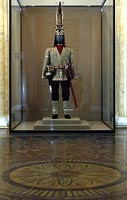05.29.2002 11:21
 On 28 May, 2002, in Apollo Room of the Winter Palace opened an exhibition from the collections of the Presidential Culture Center of the Republic of Kazakhstan (Astana), Museum of Gold and Precious Metals of the Republic of Kazakhstan (Astana) and Central State Museum of the Republic of Kazakhstan (Almaty). Prepared by the State Hermitage Museum jointly with the Ministry of Culture, Information and Public Agreement of the Republic of Kazakhstan, it marks the Days of Culture of the Republic of Kazakhstan in the Russian Federation. The exhibition shows ancient golden decorations of early nomads unearthed in Kazakhstan.
On 28 May, 2002, in Apollo Room of the Winter Palace opened an exhibition from the collections of the Presidential Culture Center of the Republic of Kazakhstan (Astana), Museum of Gold and Precious Metals of the Republic of Kazakhstan (Astana) and Central State Museum of the Republic of Kazakhstan (Almaty). Prepared by the State Hermitage Museum jointly with the Ministry of Culture, Information and Public Agreement of the Republic of Kazakhstan, it marks the Days of Culture of the Republic of Kazakhstan in the Russian Federation. The exhibition shows ancient golden decorations of early nomads unearthed in Kazakhstan.
The period when these things were created bears the conventional name of Scythian-Saka epoch, derived from the names of the two basic tribal groups that occupied the steppes of Eurasia. Blending of the Scythian and Saka cultures generated in the 7th-8th centuries B.C. the so-called animal style. Numerous golden decorations of the Sakas have been found in Kazakhstan, these are plates, straps and pendants with stylized figures of animals (tigers, elks, snow leopards, horses, wild rams, eagles, etc).
Excavation of the Issyk barrow near Almaty in 1969-1970 revealed an opulent burial which tentatively dates to the 5th or 4th centuries B.C. (though a later time, the 2nd century B.C., has been recently suggested). The tomb contained a few thousand golden plates and straps which decorated the clothes, headgear and weapons. Golden things were executed in various techniques, hammering, stamping, engraving, etc. Animal figures are dynamic and expressive. The burial was so well preserved that a reconstruction of the Saka aristocrat's costume proved possible. Things yielded by this burial complex, called ''Warrior in Golden Attire'', are presently distributed among a few museums in Kazakhstan. This original work of ancient jewelers is a successful combination of utilitarianism and creativity and a surprising synthesis of humankind's functional culture.
Another richest treasure of Saka jewelry was found in 1986 in the Almaty Region, the so-called Zhalaulinsky hoard.
In the 3rd-2nd centuries B.C. the animal style gave way to the polychromic (or encrustation) style. Colorful inserts from precious and semiprecious stones became widespread. The most remarkable collection of polychromic artifacts was unearthed in the Kargaly ravine near Almaty in 1939; it included the so-called Kargaly diadem (2nd-1st centuries B.C).
Alongside the reconstruction of the costume of the ''warrior in golden attire'' including over four thousand elements, the exhibition shows original things like golden plates in the form of trefoils and tiger heads, rectangular straps for girdles and headgear, pendants in the form of snow leopards, tigers, horned and winged horses, birds and mountains with the tree of life, spiral torque, earring with pendants, signet ring with a man's head, finger ring with a big oval protruding decoration, sword hilt and iron dagger with a sheath coated with golden sheets.
This and other jewelry showed in the exhibition is just a fraction of the ancient golden decorations created by anonymous masters of the past centuries which attest to the uniqueness of the Kazakh people's cultural heritage.
News source: Hermitage
 Print this news Print this news
Culture news archive for 29 May' 2002.
Culture news archive for May' 2002.
Culture news archive for 2002 year.
|